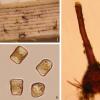
17-12-2025 18:35
 Michel Hairaud
Michel Hairaud
Bonjour à tous/Hi to everyone I am passing along

15-12-2025 15:48
 Danny Newman
Danny Newman
Melanospora cf. lagenaria on old, rotting, fallen

15-12-2025 15:54
 Johan Boonefaes
Johan Boonefaes
Unknown anamorph found on the ground in coastal sa

15-12-2025 21:11
 Hardware Tony
Hardware Tony
Small clavate hairs, negative croziers and IKI bb

15-12-2025 07:09
 Danny Newman
Danny Newman
indet. Rutstroemiaceae sp. on unk. fallen leavesMc

15-12-2025 07:05
 Danny Newman
Danny Newman
Pseudosclerococcum golindoi (det: Zotto)near Cosb

15-12-2025 11:49
 Danny Newman
Danny Newman
ITS sequences from the following two collections B

15-12-2025 12:34
 Danny Newman
Danny Newman
indet. Rhytismataceae on oak leafnear Purchase Roa
Dear Dr. Malloch,
we saw in the forum your chat with Pimpek and we're interested in Scopinella's papers, too.
We have found a specimen of Scopinella on leaves of Cortaderia selloana (Poaceae) and we think it could be a new species. However we haven't got bibliographic material about S. gallicola and S. pleiospora.
We attached a plate. The ascospores are 7.5-9.5 x 5.5-8.5 µm.
Best wishes,
Lucrecia, Virginia and Romina

(if I may "chip in") nothing on S. pleiospora, but this the description of S. gallicola (from "Scopinella gallicola, a new species from rust galls of Endocronartium harknessii on Pinus contorta" A . TSUNEDA AND Y . HIRATSUKA (CJB vol. 59)
TYPUS: In gallis Endocronartii harknessii (J. P. Moore) Y . Hiratsuka in Pinus contorta Dougl . var. latifolia Engelm. , CF B 20831.
Ascocarps nonstromatic, superficial; bases globose, at first hyaline and semitransparent, then becoming dark brown to black, 80-230 p.m diameter, with thick-walled peridial hyphae, hyaline, brown at the base, up to 150 x 5 p.m; necks straight or slightly bent, dark brown to black, pale or hyaline at the apices, slightly tapering toward the apices, mostly 230-370 u.m long, (18—)30— 45(-55) p,m wide; ostiolar hyphae rarely present.
Ascocarp peridium, dark brown to black, two- to five-layered, 9-25 p-m thick. Peridial cells isodiametric in surface view, 3-17 p.m diameter, 2- 7 p.m thick, with moderately thick walls 1-2 p.m thick. Paraphyses moniliform, 2.5-8.0 p,m diameter. Asci lining sides of the centrum wall , hyaline, 2- to 4-spored, clavate, usually short-stipitate, soon becoming evanescent, 12 - 26 x 5.0-7.5 p.m. Ascospores unicellular, barrel-
shaped, pale brown, brown to black in mass, hyaline at the ends, smooth, 3.5-8.0 x 2.9-6.5 p.m. ?
clearly a different taxon to what you have found
un cordial saludo! / best wishes
Chris
Hello Chris,
you're right, S. gallicola has nothing to do with our species. Thank you very much for the information!!!
Regard to S. pleiospora, we found it in the Index Fungorum (www.indexfungorum.org) list of Scopinella's species and we don't know when it was rejected as a member of the genus.
Cordialement,
Lucrecia, Virginia and Romina

